Charles E W Bean, Diaries, AWM38 3DRL 606/270 PART 3/1 - 1918 - 1939 - Part 8
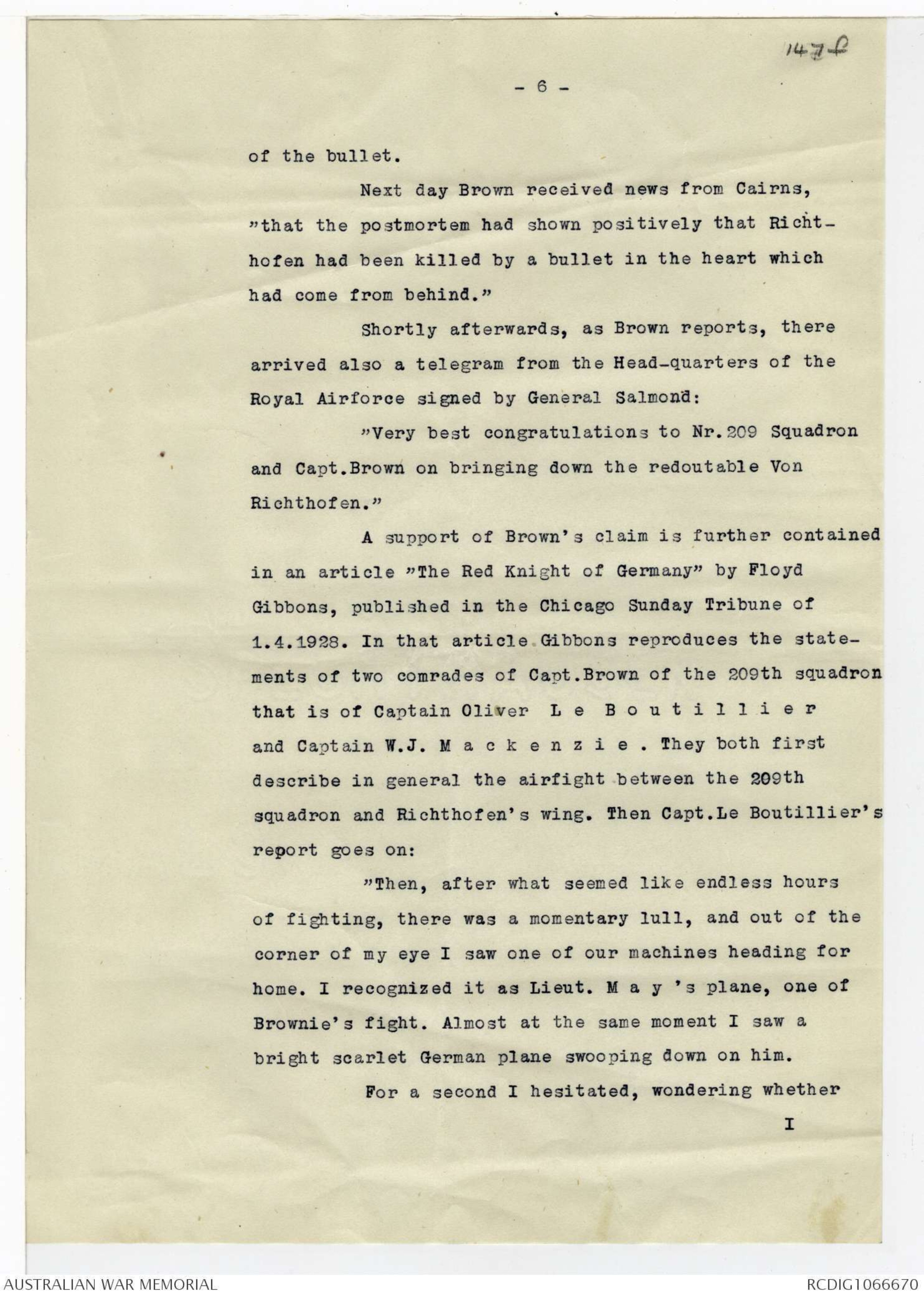
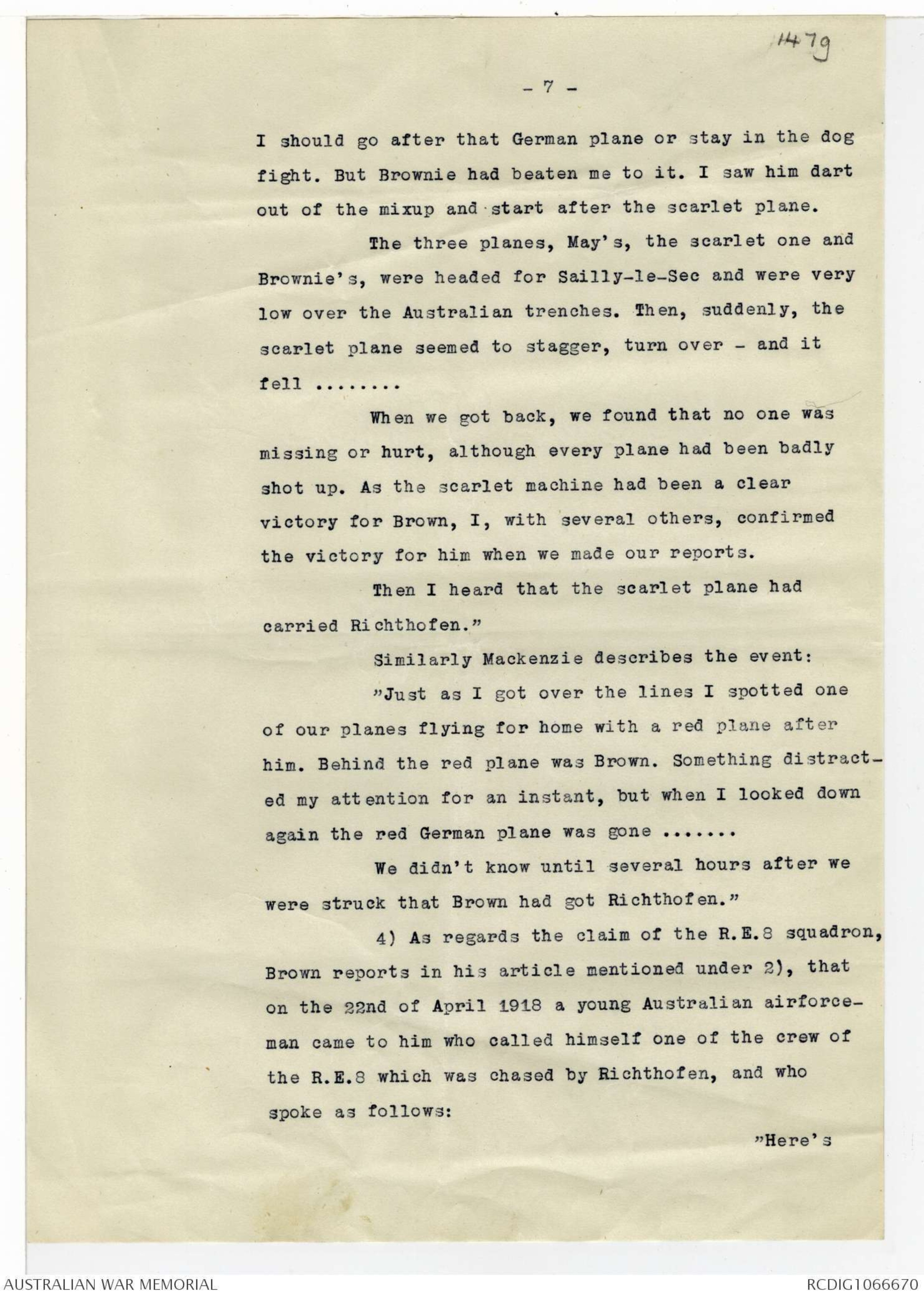
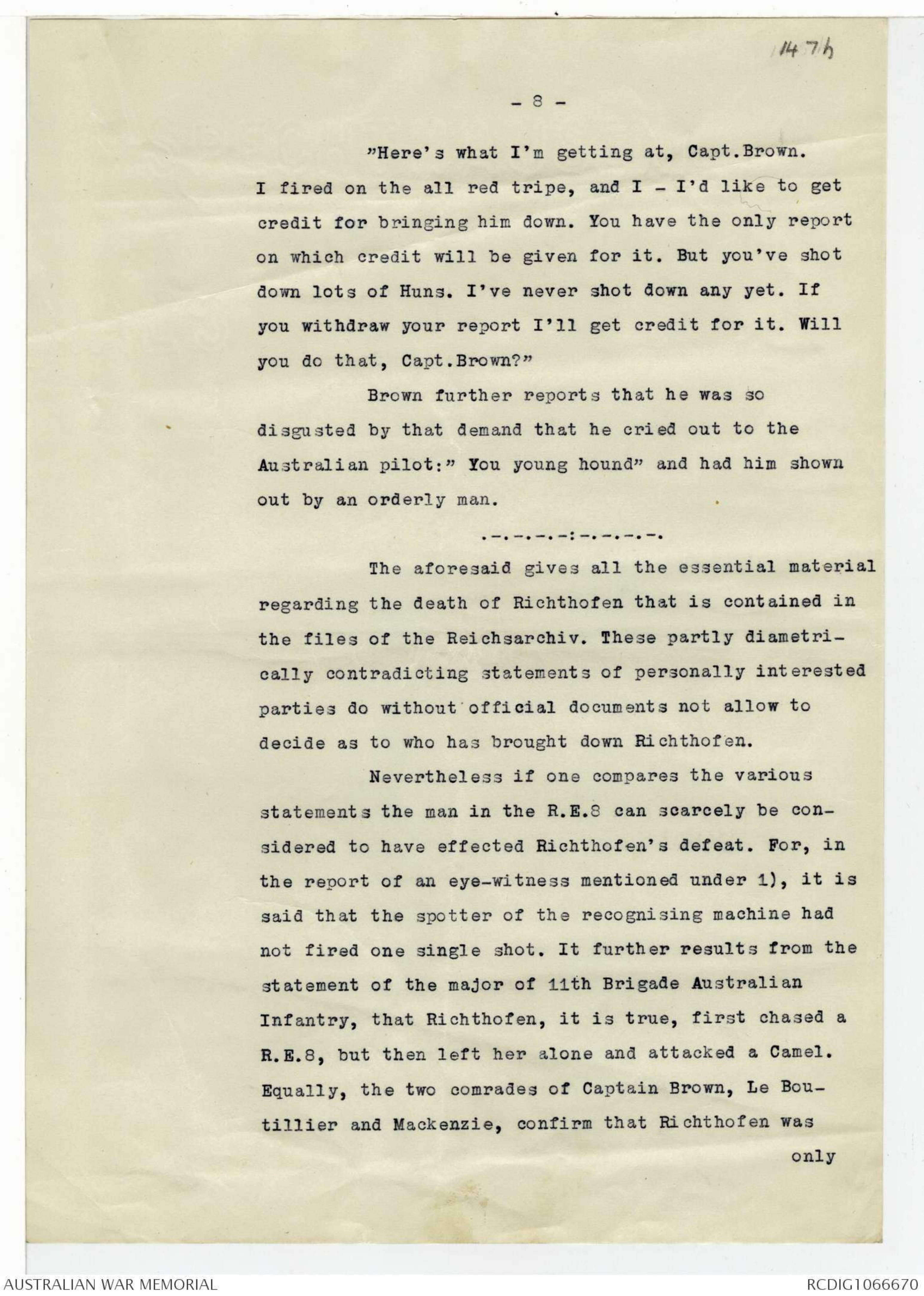
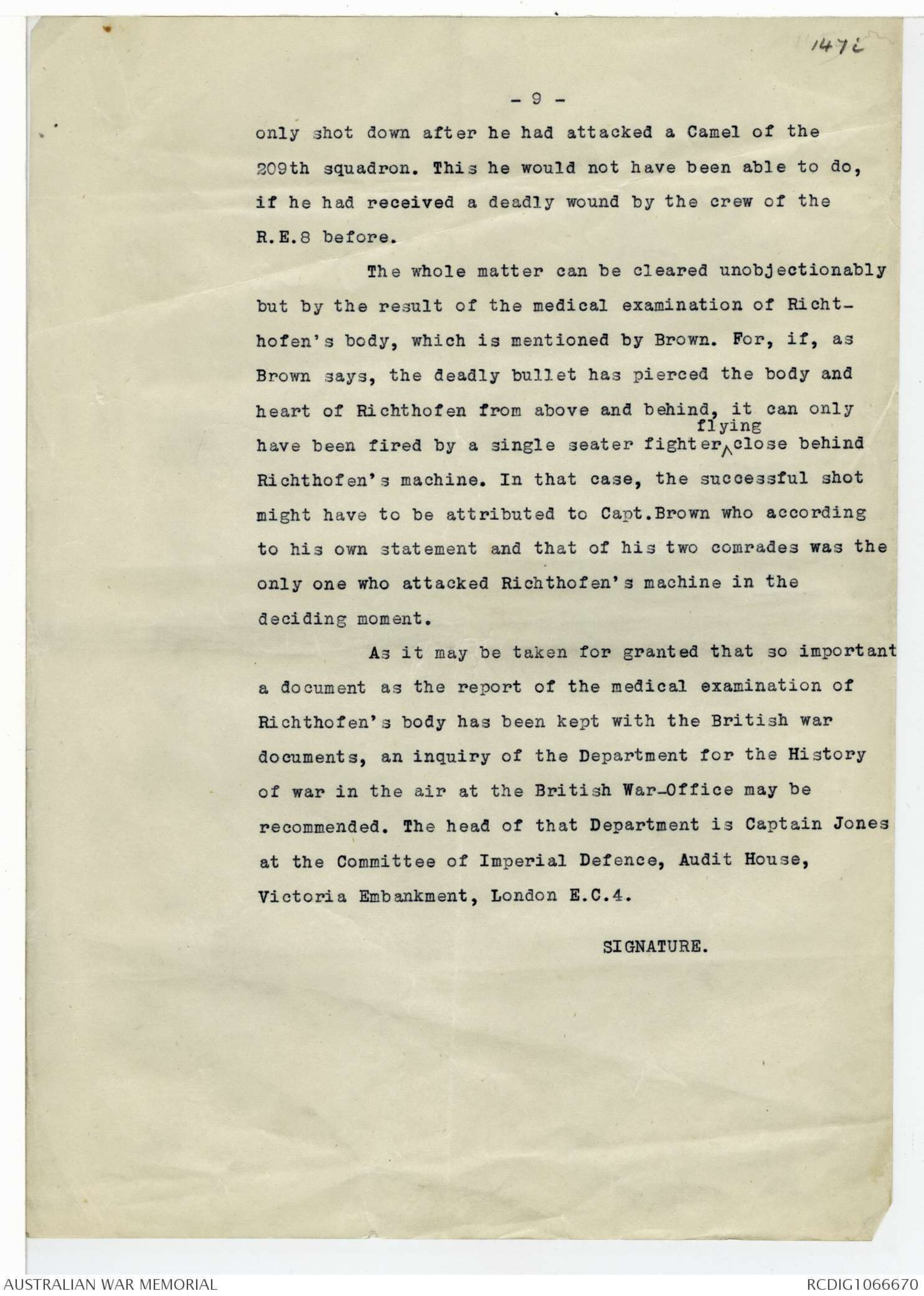
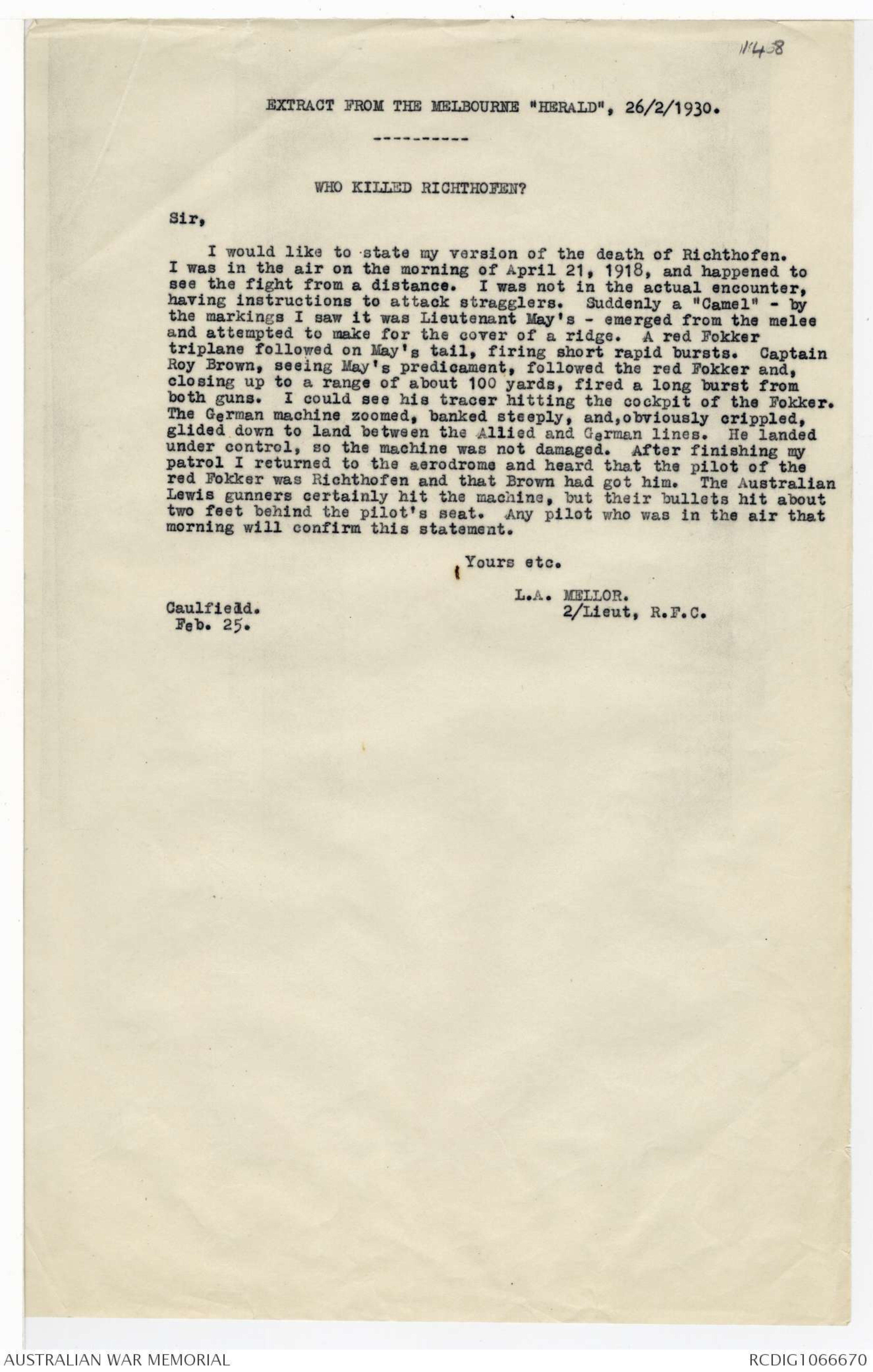
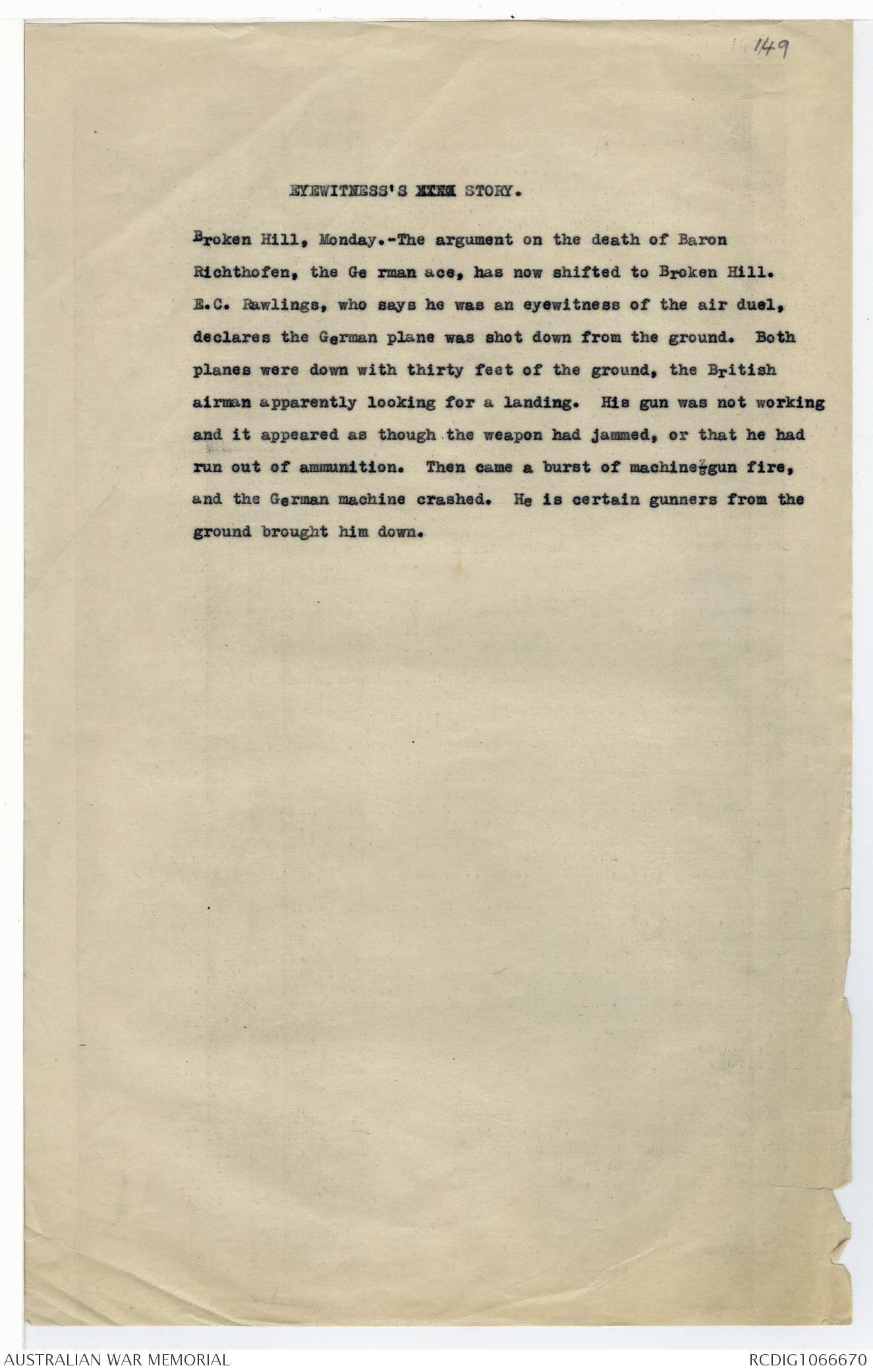


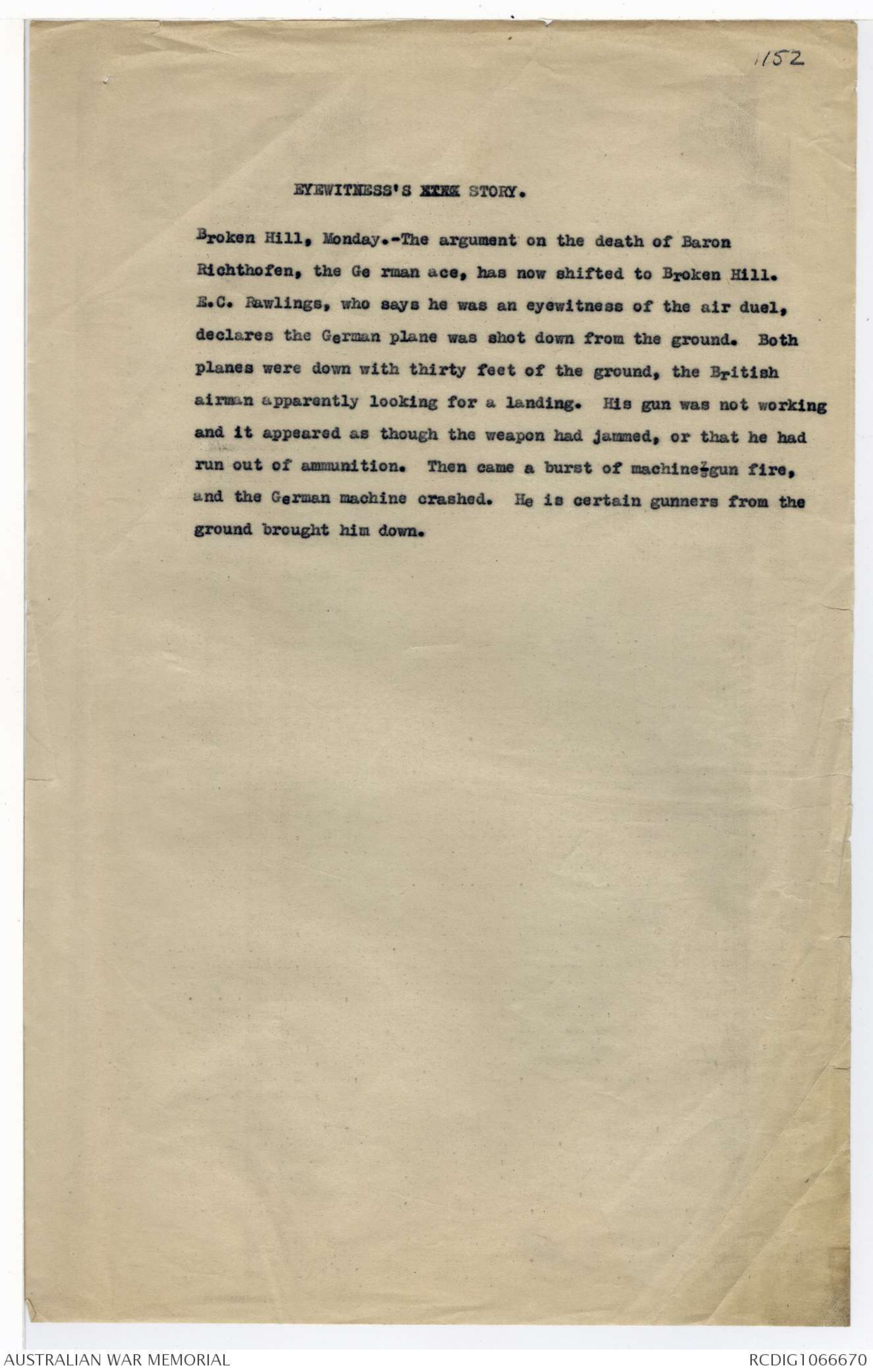
147f
-6 -
of the bullet.
Next day Brown received news from Cairns,
"that the postmortem had shown positively that Richthofen
had been killed by a bullet in the heart which
had come from behind."
Shortly afterwards, as Brown reports, there
arrived also a telegram from the Head-quarters of the
Royal Airforce signed by General Salmond:
"Very best congratulations to Nr.209 Squadron
and Capt. Brown on bringing down the redoutable Von
Richthofen."
A support of Brown's claim is further contained
in an article "The Red Knight of Germany" by Floyd
Gibbons, published in the Chicago Sunday Tribune of
1.4.1928. In that article Gibbons reproduces the statements
of two comrades of Capt. Brown of the 209th squadron
that is of Captain Oliver Le Boutillier
and Captain W.J. Mackenzie. They both first
describe in general the airfight between the 209th
squadron and Richthofen's wing. Then Capt. Le Boutillier's
report goes on:
"Then, after what seemed like endless hours
of fighting, there was a momentary lull, and out of the
corner of my eye I saw one of our machines heading for
home. I recognized it as Lieut. May's plane, one of
Brownie's fight. Almost at the same moment I saw a
bright scarlet German plane swooping down on him.
For a second I hesitated, wondering whether
I
147g
-7 -
I should go after that German plane or stay in the dog
fight. But Brownie had beaten me to it. I saw him dart
out of the mixup and start after the scarlet plane.
The three planes, May's, the scarlet one and
Brownie's, were headed for Sailly-le-Sec and were very
low over the Australian trenches. Then, suddenly, the
scarlet plane seemed to stagger, turn over - and it
fell . . . . . . . .
When we got back, we found that no one was
missing or hurt, although every plane had been badly
shot up. As the scarlet machine had been a clear
victory for Brown, I, with several others, confirmed
the victory for him when we made our reports.
Then I heard that the scarlet plane had
carried Richthofen."
Similarly Mackenzie describes the event:
"Just as I got over the lines I spotted one
of our planes flying for home with a red plane after
him. Behind the red plane was Brown. Something distracted
my attention for an instant, but when I looked down
again the red German plane was gone . . . . . .
We didn't know until several hours after we
were struck that Brown had got Richthofen."
4) As regards the claim of the R.E.8 squadron,
Brown reports in his article mentioned under 2), that
on the 22nd of April 1918 a young Australian airforceman
came to him who called himself one of the crew of
the R.E.8 which was chased by Richthofen, and who
spoke as follows:
"Here's
147h
-8-
"Here's what I'm getting at, Capt. Brown.
I fired on the all red tripe, and I - I'd like to get
credit for bringing him down. You have the only report
on which credit will be given for it. But you've shot
down lots of Huns. I've never shot down any yet. If
you withdraw your report I’ll get credit for it. Will
you do that, Capt. Brown?"
Brown further reports that he was so
disgusted by that demand that he cried out to the
Australian pilot: "You young hound" and had him shown
out by an orderly man.
The aforesaid gives all the essential material
regarding the death of Richthofen that is contained in
the files of the Reichsarchiv. These partly diametrically
contradicting statements of personally interested
parties do without official documents not allow to
decide as to who has brought down Richthofen.
Nevertheless if one compares the various
statements the man in the R.E.8 can scarcely be considered
to have effected Richthofen's defeat. For, in
the report of an eye-witness mentioned under 1), it is
said that the spotter of the recognising machine had
not fired one single shot. It further results from the
statement of the major of 11th Brigade Australian
Infantry, that Richthofen, it is true, first chased a
R.E.8, but then left her alone and attacked a Camel.
Equally, the two comrades of Captain Brown, Le Boutillier
and Mackenzie, confirm that Richthofen was
only
147L
-9-
only shot down after he had attacked a Camel of the
209th squadron. This he would not have been able to do,
if he had received a deadly wound by the crew of the
R.E.8 before.
The whole matter can be cleared unobjectionably
but by the result of the medical examination of Richthofen's
body, which is mentioned by Brown. For, if, as
Brown says, the deadly bullet has pierced the body and
heart of Richthofen from above and behind, it can only
have been fired by a single seater fighter ^ flying close behind
Richthofen's machine. In that case, the successful shot
might have to be attributed to Capt. Brown who according
to his own statement and that of his two comrades was the
only one who attacked Richthofen's machine in the
deciding moment.
As it may be taken for granted that so important
a document as the report of the medical examination of
Richthofen's body has been kept with the British war
documents, an inquiry of the Department for the History
of war in the air at the British War-Office may be
recommended. The head of that Department is Captain Jones
at the Committee of Imperial Defence, Audit House,
Victoria Embankment, London E.C.4.
SIGNATURE.
148
EXTRACT FROM THE MELBOURNE "HERALD", 26/2/1930.
WHO KILLED RICHTHOFEN?
Sir,
I would like to state my version of the death of Richthofen.
I was in the air on the morning of April 21, 1918, and happened to
see the fight from a distance. I was not in the actual encounter,
having instructions to attack stragglers. Suddenly a "Camel" - by
the markings I saw it was Lieutenant May's - emerged from the melee
and attempted to make for the cover of a ridge. A red Fokker
triplane followed on May's tail, firing short rapid bursts. Captain
Roy Brown, seeing May's predicament, followed the red Fokker and,
closing up to a range of about 100 yards, fired a long burst from
both guns. I could see his tracer hitting the cockpit of the Fokker.
The German machine zoomed, banked steeply, and,obviously crippled,
glided down to land between the Allied and German lines. He landed
under control, so the machine was not damaged. After finishing my
patrol I returned to the aerodrome and heard that the pilot of the
red Fokker was Richthofen and that Brown had got him. The Australian
Lewis gunners certainly hit the machine, but their bullets hit about
two feet behind the pilot's seat. Any pilot who was in the air that
morning will confirm this statement.
Yours etc.
L.A. MELLOR.
2/Lieut, R.F.C.
Caulfield.
Feb. 25.
149
EYEWITNESS'S XXXX STORY.
Broken Hill, Monday.-The argument on the death of Baron
Richthofen, the German ace, has now shifted to Broken Hill.
E.C. Rawlings, who says he was an eyewitness of the air duel,
declares the German plane was shot down from the ground. Both
planes were down with thirty feet of the ground, the British
airman apparently looking for a landing. His gun was not working
and it appeared as though the weapon had jammed, or that he had
run out of ammunition. Then came a burst of machine-gun fire,
and the German machine crashed. He is certain gunners from the
ground brought him down.
150
NEWSPAPER CUTTING SENT BY SERGT. POPKIN.
That Vickers machine-gun was fired by Sergeant Popkin. This is
his story as told to the writer, who at the time was with the 7th
Infy. Bde. in the sector to the left, and who, from reports at the
time, has always been convinced that an Australian machine-gunner
brought the German ace down.
"I was in charge of four Vickers guns on the bank of the
Canal between Sailly le Sec and Corbie," says Digger Popkin, "and had
a gun mounted for anti-aircraft defence. About 11 o'clock and
British and German squadron started a battle in mid-air. Presently
two planes separated from the rest and headed for our lines, flying
over Sailly le Sec. They came straight along the canal towards my
gun position. I immediately got into position and waited.
"On came the planes, the Britisher in front and about 60
feet in the air. They were so close together that I had to wait for
the Britisher to pass. Then I opened up on the German machine.- a
red triplane. I fired about 80 rounds and he immediately turned at
right angles to my position and banked to clear the top of the ridge
on the left of the canal looking towards the line. He then turned
round and flew straight towards my gun. I opened fire again and
gave him another 80 rounds. The plane started to dive, described a
half-circile, and crashed into the ground on top of the ridge near a
quarry, and facing Bonnay.
"I immediately rushed up the hill and on arrival a couple of
minutes after the crash found the wrecked plane surrounded by infantry
officers who would not allow anybody to touch it. However, I stepped
in and wrenched a piece off one of the wings for a souvenir. About an
hour later an intelligence officer of the 11th Brigade came and took
my regimental particulars and told me who I had shot down. About 6
o'clock the same evening a liaison officer of the 52nd Battalion,
with his report written out, saw me and he also took my regimental
particulars to support my claim. The colenel of the 52nd also
supported my claim, but owing to the report from my company going in
a week after the incident, I am afraid I got very little consideration. xxxxxxxxxxxxxxxxxxxxxxx
"Anyone wishing to verify these statements," concluded
Digger Popkin, "can do so by getting in touch with Captain F. Watts,
late of the 24th M.G. Company, and now residing at Byron Bay, who
was in charge of the section at the time; also Captain Crouch of
Waverley and Major Hinton, M.C., who, I think, lives in Sydney also."
Sergeant Popkin pointed out the absurdity of the claim of
Captain Brown, the English airman whom Richthofen chased, that he
brought the German down. With fixed machine-guns which fire through
the propeller, it seemed impossible that he could have done so, as
the German was xxx pursuing him and kept on his tail all the way.
Mr. W.J. Warnsford, formerly an officer of the 3rd Australian Flying
Squadron, who was sent to salvage the machine, and to recover Richthofen's
body, says that from an examination of the remnants of the
German machine, he concluded that Richthofen's gun had jammed, and
that Richthofen, being a very smart and dare-devil pilot, still kept
on the tail of Capt. Brown's machine. Apparently, the Englishman was
lucky to escape.
Richthofen, who had brought down 80 planes, was buried with
military honours behind the British line. A large number of British
fighting men and aviation officers, as well as Americans stationed at
a neighbonring aerodrome, attended. Mechanics of an Australian
aviation squadron had constructed a coffin, on which they placed a
plate giving the aviator's name, rank, and other data.
The Baron was buried under a hemlock tree, and the squad
fired the last shots across the grave. The grave was covered with
flowers - Australia's tribute to a gallant foe.
151
NEWSPAPER CUTTING SENT BY SERGT. POPKIN.
That Vickers machine-gun was fired by Sergeant Popkin. This is
his story as told to the writer, who at the time was with the 7th
Infy. Bde. in the sector to the left, and who, from reports at the
time, has always been convinced that an Australian machine-gunner
brought the German ace down.
"I was in charge of four Vickers guns on the bank of the
Canal between Sailly le Sec and Corbie," says Digger Popkin, "and had
a gun mounted for anti-aircraft defence. About 11 o'clock and
British and German squadron started a battle in mid-air. Presently
two planes separated from the rest and headed for our lines, flying
over Sailly le Sec. They came straight along the canal towards my
gun position. I immediately got into position and waited.
"On came the planes, the Britisher in front and about 60
feet in the air. They were so close together that I had to wait for
the Britisher to pass. Then I opened up on the German machine.- a
red triplane. I fired about 80 rounds and he immediately turned at
right angles to my position and banked to clear the top of the ridge
on the left of the canal looking towards the line. He then turned
round and flew straight towards my gun. I opened fire again and
gave him another 80 rounds. The plane started to dive, described a
half-circile, and crashed into the ground on top of the ridge near a
quarry, and facing Bonnay.
"I immediately rushed up the hill and on arrival a couple of
minutes after the crash found the wrecked plane surrounded by infantry
officers who would not allow anybody to touch it. However, I stepped
in and wrenched a piece off one of the wings for a souvenir. About an
hour later an intelligence officer of the 11th Brigade came and took
my regimental particulars and told me who I had shot down. About 6
o'clock the same evening a liaison officer of the 52nd Battalion,
with his report written out, saw me and he also took my regimental
particulars to support my claim. The colenel of the 52nd also
supported my claim, but owing to the report from my company going in
a week after the incident, I am afraid I got very little consideration. xxxxxxxxxxxxxxxxxxxxxxx
"Anyone wishing to verify these statements," concluded
Digger Popkin, "can do so by getting in touch with Captain F. Watts,
late of the 24th M.G. Company, and now residing at Byron Bay, who
was in charge of the section at the time; also Captain Crouch of
Waverley and Major Hinton, M.C., who, I think, lives in Sydney also."
Sergeant Popkin pointed out the absurdity of the claim of
Captain Brown, the English airman whom Richthofen chased, that he
brought the German down. With fixed machine-guns which fire through
the propeller, it seemed impossible that he could have done so, as
the German was xxx pursuing him and kept on his tail all the way.
Mr. W.J. Warnsford, formerly an officer of the 3rd Australian Flying
Squadron, who was sent to salvage the machine, and to recover Richthofen's
body, says that from an examination of the remnants of the
German machine, he concluded that Richthofen's gun had jammed, and
that Richthofen, being a very smart and dare-devil pilot, still kept
on the tail of Capt. Brown's machine. Apparently, the Englishman was
lucky to escape.
Richthofen, who had brought down 80 planes, was buried with
military honours behind the British line. A large number of British
fighting men and aviation officers, as well as Americans stationed at
a neighbonring aerodrome, attended. Mechanics of an Australian
aviation squadron had constructed a coffin, on which they placed a
plate giving the aviator's name, rank, and other data.
The Baron was buried under a hemlock tree, and the squad
fired the last shots across the grave. The grave was covered with
flowers - Australia's tribute to a gallant foe.
152
EYEWITNESS'S XXEX STORY.
Broken Hill, Monday.- The argument on the death of Baron
Richthofen, the German ace, has now shifted to Broken Hill.
E.C. Rawlings, who says he was an eyewitness of the air duel,
declares the German plane was shot down from the ground. Both
planes were down with thirty feet of the ground, the British
airman apparently looking for a landing. His gun was not working
and it appeared as though the weapon had jammed, or that he had
run out of ammunition. Then came a burst of machine-gun fire,
and the German machine crashed. He is certain gunners from the
ground brought him down.
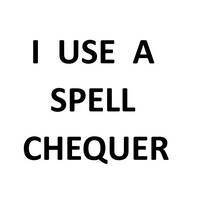 Not Yet Replaced By AI
Not Yet Replaced By AIThis transcription item is now locked to you for editing. To release the lock either Save your changes or Cancel.
This lock will be automatically released after 60 minutes of inactivity.